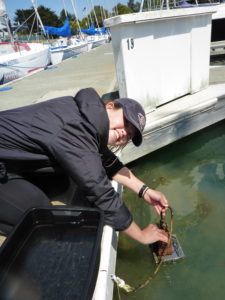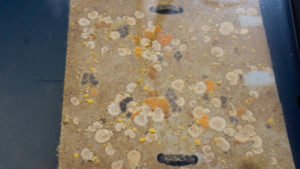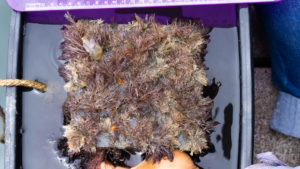By Philip Kiefer
Roughly half of the species living in the San Francisco Bay are newcomers, brought (often unintentionally) by humans. The Bay has been an international shipping hub for over a century, and it’s accumulated biological detritus from around the world. But not everything that’s brought here sticks: It’s something of a mystery why some species proliferate in an alien environment while others die off.
This summer, two interns at the Smithsonian Environmental Research Center’s West Coast branch (SERC-West), investigated how one invader cements itself in the environment during environmental chaos. Jenny Par and Kenyan Pappe looked at the golden star tunicate Botryllus schlosseri, a type of marine invertebrate that often lives around marinas.
Tunicates are our filter-feeding cousins. As adults, they’re amorphous lumps stuck to hard surfaces near the seashore. They’ve got a distinctly visceral quality: One variety has been likened to a zombie heart, and another resembles a leathery cucumber. But as larvae, they’re more familiar: They swim around, searching for a home, and have a proto-spinal column, placing them closer to mammals than any other class of invertebrate. Golden star tunicates are colonial – each organism is actually a group of clones, arranged in star-shaped clusters, sharing a system of blood vessels.
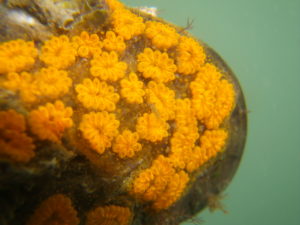
The golden star tunicate Botryllus schlosseri is a fast-growing tunicate that takes advantage of disturbed ecosystems, like an estuarine fireweed.
(Credit: Melissa Frey)
The golden star tunicate isn’t as destructive as the ash beetle or Asian carp. It doesn’t eat its way through the existing ecosystem, or carpet the seafloor. Mostly, it sits in place filtering nutrients from the water. There’s some evidence that it may outcompete certain native species, but it’s not going to be the kudzu of the Bay. Even though the spread of star tunicates isn’t an obvious catastrophe, it can still offer insight into the “causes and consequences of diversity in general,” according to Andrew Chang, lead scientist at SERC-West. By studying how the star tunicate establishes itself in an ecosystem, SERC scientists hope to understand how different species compete for limited space in a changing environment.
Previous work at SERC suggested other fouling organisms outcompeted star tunicates, and perhaps actively suppressed their spread. But recent wet winters wiped out some of these competitors, which led Par and Pappe to wonder how the golden star tunicate might respond to such an opportunity.
They investigated two harbors with vastly different ecosystems in the San Francisco Bay: Richmond and San Leandro. The water in Richmond is much cleaner and is regularly flushed out by tides. San Leandro is stagnant, and so environmental changes linger. There, the fresh water from two years ago still affects the ecosystem. As a consequence, Richmond is much more diverse than San Leandro—where they’ve only found six distinct species—creating different levels of competition for the golden star tunicate.
“We’re taking advantage of the lasting legacy of the wet winter’s different effects on San Leandro versus Richmond to see how a species that is still in both places is performing,” explained Chang.
In the two harbors, Pappe and Par mimicked the effects of environmental upheavals. First, they set out hard panels in local marinas, designed to attract whatever might be living nearby: milky sea-grapes, purple, brushy bryozoans, the occasional mollusk. Once a colony established itself, Pappe and Par ravaged it. On some panels, they peeled off every star tunicate; on others, they wiped out everything else. On a third set, they went full Godzilla, scraping off a certain proportion of organisms at random.
Then they watched how the colonies recovered from the carnage. As might be expected, on panels where only star tunicates were left, the tunicate thrived. But on panels where they removed the golden star tunicate, it grew back as quickly as they could take it off. When Pappe and Par returned to panels two weeks after removing every golden star, their populations had largely rebounded. Meanwhile, recruitment plates—blank panels left out every two weeks to measure the natural settlement from the water column—showed that star tunicates were extremely abundant at first, and then were slowly dominated by other species.
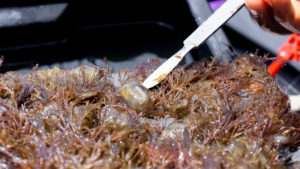
On some plates, the researchers mimicked environmental catastrophes by removing some of the growth. (Philip Kiefer/SERC)
Even on the fouling plates, different animals are filling different evolutionary niches. Think of the plates like a forest: When a fire sweeps through the forest, the open space is filled by fast-growing fireweed and Indian paintbrush. The hardier trees grow more slowly, but eventually they dominate.
“It just doesn’t look like [the star tunicate] is a strong competitor,” said Chang. Instead, they’re like the fireweed, quickly filling open space, then disappearing as the system matures.
This picture of golden star tunicates confirms earlier findings on the tunicates’ place in an ecosystem. Two winters ago, heavy rains sent a pulse of fresh water in the San Francisco Bay, wiping out the star tunicate’s salt water-loving competitors. The hardy golden stars thrived in the open space—much like the fields of fireweed and Indian paintbrush that spring up in the wake of wildfires.
“The plates we were pulling up that year just looked completely different,” Chang said. “They were covered in colonial tunicates like the golden star. Lots of reds and golds—more aesthetically pleasing, maybe.” But once the saltwater returned, the golden star tunicates receded.
The irony is that golden star tunicates are just one species in a forest of invaders. Almost everything else that coats the plates was also introduced by humans, and the few things that aren’t clearly invasive are of unknown origin, not necessarily native. What scientists are observing on these plates, therefore, isn’t exactly like watching an invasive species establish itself in a new place. It’s more like watching the dynamics of a Frankenstein ecosystem, where every species is just learning to work with the others.

